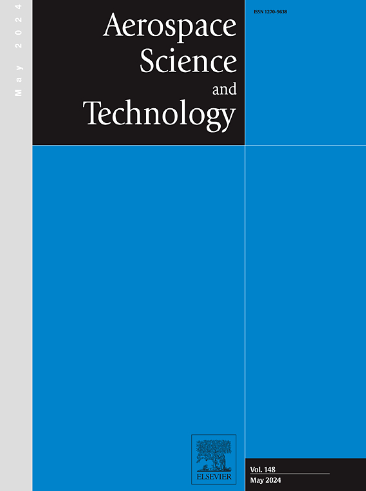Comparative analysis of the bending crashworthiness of CFRP, metal and CFRP/metal hybrid C-frames
IF 5.8
1区 工程技术
Q1 ENGINEERING, AEROSPACE
引用次数: 0
Abstract
Aircraft fuselage frames are the critical energy-absorbing structures, with bending failure being the primary and the most complex failure mode during crash events. A finite element model was validated through a four-point bending test of a carbon fiber reinforced plastic (CFRP) C-frame. A comprehensive comparative analysis was conducted on the bending failure behavior and energy absorption performance of C-frames made from CFRPs, metals (aluminum alloy (Al) and titanium alloy (Ti)), and their hybrid configurations (CFRP/Al and CFRP/Ti). The results showed that, under four-point bending load, all C-frames exhibited consistent local buckling in the midsection of the compressed upper flange, with failure initiating at the upper flange-web junction due to the material’s compressive failure strain. The CFRP C-frames exhibited limited energy absorption performance due to brittle fracture. Whereas the Al and Ti C-frames exhibited superior energy absorption performance via mechanisms such as local buckling, plastic deformation and ductile fracture. The CFRP/metal hybrid C-frames effectively combined the advantages of metals and CFRPs, significantly enhancing residual structural integrity and energy absorption performance through metal-induced plastic deformation and controlled CFRP failure. Compared with the CFRP C-frames, the CFRP/metal hybrid C-frames exhibited 62.9 % to 238.4 % improvement in energy absorption, 16.4 % to 73.6 % improvement in specific energy absorption, and 62.8 % to 238.1 % improvement in mean bending force. Notably, the designs with metal layer positioned outside optimally leveraged the metal’s properties, outperforming configurations with the metal layer positioned inside. These findings provide critical insights into the bending crashworthiness design of fuselage frames.
CFRP、金属及CFRP/金属混合c型框架弯曲耐撞性对比分析
飞机机身框架是关键的吸能结构,弯曲失效是飞机碰撞中最主要也是最复杂的失效形式。通过碳纤维增强塑料(CFRP) c型框架的四点弯曲试验,对有限元模型进行了验证。对CFRP、金属(铝合金(Al)和钛合金(Ti))及其混合结构(CFRP/Al和CFRP/Ti) c型框架的弯曲破坏行为和吸能性能进行了全面对比分析。结果表明,在四点弯曲荷载作用下,所有c型框架在压缩上翼缘中部均表现出一致的局部屈曲,由于材料的压缩破坏应变,破坏始于上翼缘-腹板连接处。碳纤维布c型框架由于脆性断裂,其吸能性能有限。而Al和Ti c -框架通过局部屈曲、塑性变形和韧性断裂等机制表现出优异的吸能性能。CFRP/金属复合c型框架有效地结合了金属和CFRP的优点,通过金属引起的塑性变形和控制CFRP破坏,显著提高了剩余结构的完整性和吸能性能。与CFRP碳纤维复合材料c -框架相比,CFRP/金属复合材料c -框架吸能提高62.9% ~ 238.4%,比能提高16.4% ~ 73.6%,平均弯曲力提高62.8% ~ 238.1%。值得注意的是,金属层位于外部的设计最佳地利用了金属的性能,优于金属层位于内部的配置。这些发现为机身框架的弯曲耐撞性设计提供了重要的见解。
本文章由计算机程序翻译,如有差异,请以英文原文为准。
求助全文
约1分钟内获得全文
求助全文
来源期刊

Aerospace Science and Technology
工程技术-工程:宇航
CiteScore
10.30
自引率
28.60%
发文量
654
审稿时长
54 days
期刊介绍:
Aerospace Science and Technology publishes articles of outstanding scientific quality. Each article is reviewed by two referees. The journal welcomes papers from a wide range of countries. This journal publishes original papers, review articles and short communications related to all fields of aerospace research, fundamental and applied, potential applications of which are clearly related to:
• The design and the manufacture of aircraft, helicopters, missiles, launchers and satellites
• The control of their environment
• The study of various systems they are involved in, as supports or as targets.
Authors are invited to submit papers on new advances in the following topics to aerospace applications:
• Fluid dynamics
• Energetics and propulsion
• Materials and structures
• Flight mechanics
• Navigation, guidance and control
• Acoustics
• Optics
• Electromagnetism and radar
• Signal and image processing
• Information processing
• Data fusion
• Decision aid
• Human behaviour
• Robotics and intelligent systems
• Complex system engineering.
Etc.
 求助内容:
求助内容: 应助结果提醒方式:
应助结果提醒方式:


